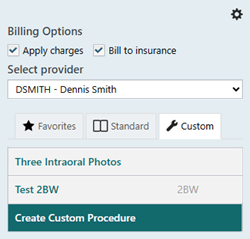Creating custom imaging procedures
Dentrix Ascend Imaging comes with several default imaging procedures. However, you can create a custom imaging procedure by defining a template (such as a six-image periapical template). The imaging procedure will be available to every user who has rights to acquire images.
Note: Custom and favorite imaging procedures are location specific.
To create a custom imaging procedure (template)
-
If you are not already viewing the correct location, select it on the Location menu.
-
If the correct patient is not already selected, use the Patient Search box to access the patient's record.
Note: You can include inactive patients in the search results by setting the Include inactive patients switch to On.
-
On the Patient menu, under Clinical, select Chart, Progress Notes, Quick Exam, Perio, Tx Planner, or Imaging.
-
On the Chart, Progress Notes, Perio, Tx Planner, or Imaging tab of a patient's clinical record, on the Imaging tab's menu, select Acquire images.

The options for acquiring images become available.

-
On the navigation panel, select the Custom tab.

Any existing custom imaging procedures are listed. Also, at the bottom of the list, there is an option for creating an imaging procedure.
-
Click (or tap) Create Custom Procedure.

The options to set up the imaging procedure become available.

-
Enter a name for the imaging procedure in the Procedure Name box. The name can be up to 11 characters long.
-
Enter a valid procedure code or a multi-code in the Code box. The specified code will be posted to a patient's record when this imaging procedure is used to acquire images. However, if the code is invalid, an error message will appear during acquisition, and the code will not be posted.
-
Set the default state for the following checkboxes (which are available only if a Code is entered):
-
Apply charges - Select or clear this checkbox to specify whether you want to have the fee or a zero amount, respectively, posted for the specified Code by default. This can be changed at the time of acquisition.
-
Bill to insurance - Select or clear this checkbox to specify whether you want to have the patient's insurance carrier billed or not billed, respectively, for the specified Code by default. This can be changed at the time of acquisition.
-
-
Select the Intraoral X-ray, Intraoral photo, or Extraoral photo option
 to specify the acquisition type for the imaging procedure.
to specify the acquisition type for the imaging procedure.Note: Once you save the imaging procedure, you cannot change the acquisition type.
-
Add image placeholders to the template as needed (the order in which you add them determines the default acquisition order):
-
Click (or tap) Add Horizontal or Add Vertical.
Note: If there is not enough horizontal space to display the buttons, on the Add Placeholder menu that appears, select the Add Horizontal or Add Vertical option.

-
Drag the placeholder to the desired spot on the template.

-
If needed, you can click (or tap) the Rotate button
 to switch the orientation of the placeholder.
to switch the orientation of the placeholder. -
To proportionally resize the placeholder, drag the resizing handle (the angled bracket in the lower-right corner of the placeholder) either diagonally down and to the right or diagonally up and to the left. Afterward, you may need to drag the placeholder to reposition it on the template.

-
To align the top edge of the placeholder with the top edge of another placeholder, select the Align horizontally to selection option
 of the placeholder to align, and then click (or tap) the placeholder to align it with.
of the placeholder to align, and then click (or tap) the placeholder to align it with.
-
To align the left edge of the placeholder with the left edge of another placeholder, select the Align vertically to selection option
 of the placeholder to align, and then click (or tap) the placeholder to align it with.
of the placeholder to align, and then click (or tap) the placeholder to align it with.
-
To resize the placeholder to be the same size as another placeholder, select the Resize to selection option
 of the placeholder to resize, and then click (or tap) the placeholder to resize it to.
of the placeholder to resize, and then click (or tap) the placeholder to resize it to.
-
For a template with intraoral X-rays or photos, to assign tooth numbers to the placeholder, click (or tap) the Edit button
 to open the the Assign Tooth Numbers dialog box, select the applicable teeth, and then click (or tap) Assign Teeth.
to open the the Assign Tooth Numbers dialog box, select the applicable teeth, and then click (or tap) Assign Teeth.
-
Repeat steps a-h as needed to add other placeholders.
Note: To remove a placeholder, with that placeholder selected, click (or tap) Remove.
-
-
If the template is not for a mirrored exam (images should be displayed as if you are looking into the patient's mouth), leave the Mirrored Exam checkbox clear. However, if the template is for a mirrored exam (images should be displayed as if you are looking out from the patient's mouth), select the Mirrored Exam checkbox to have the images flipped on the horizontal axis.
-
To view or change the default acquisition order, click (or tap) Set Order.
Numbers appear on the placeholders to indicate the order.

To change the order, do the following:
-
Click (or tap) Reset to remove the order number from every placeholder.
-
Click (or tap) each placeholder in the order that you want to acquire the images.
Note: To undo order assignments, click (or tap) Undo as needed.
-
When you have assigned an order to every placeholder, click (or tap) Finish.
The imaging procedure is ready to be saved.

-
-
Click (or tap) Save.